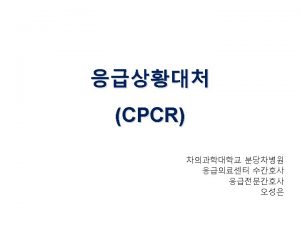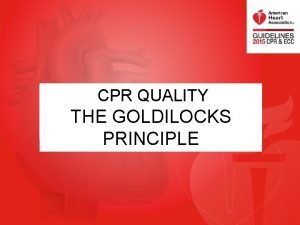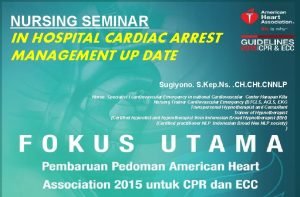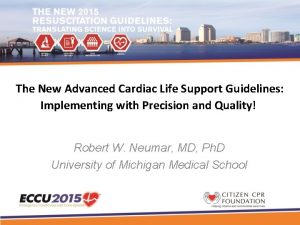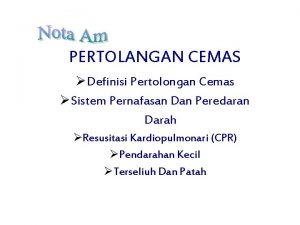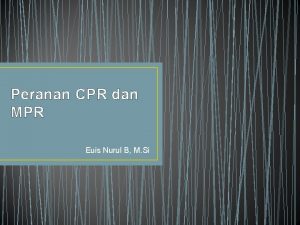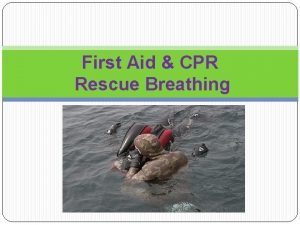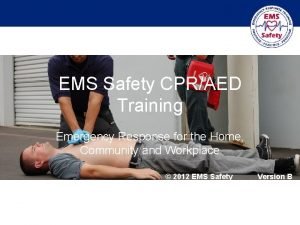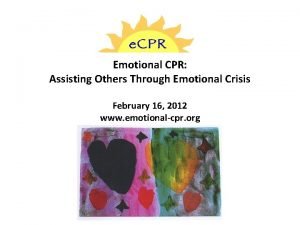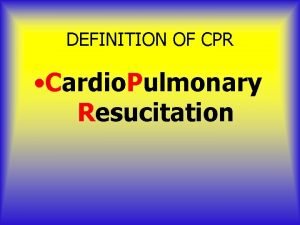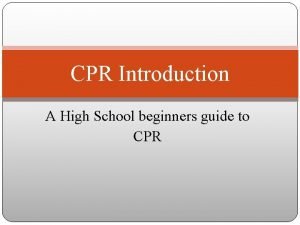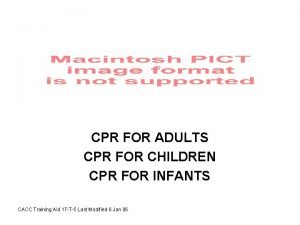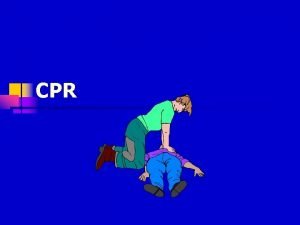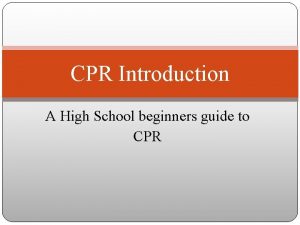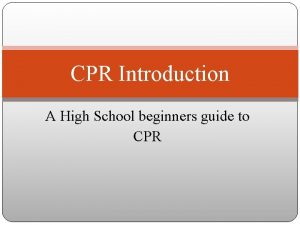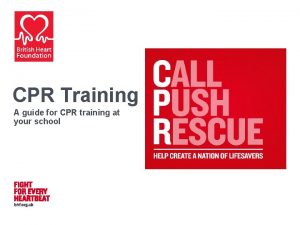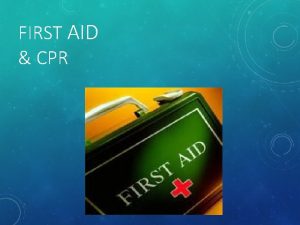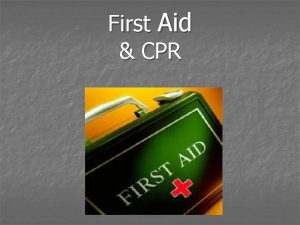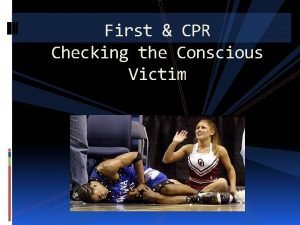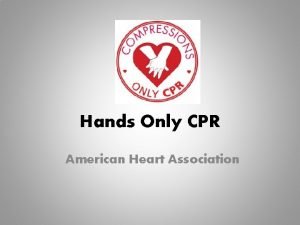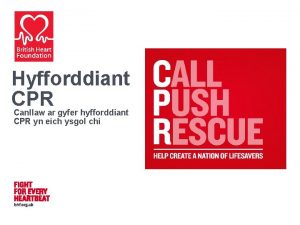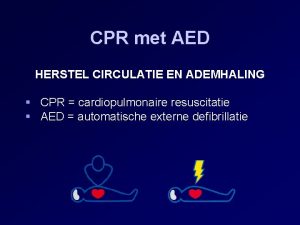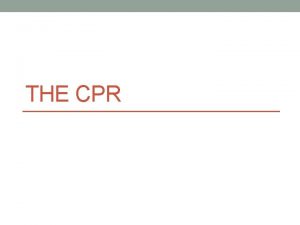CPR Introduction A Mukwonago High School guide to




























- Slides: 28

CPR Introduction A Mukwonago High School guide to CPR 2013

What do you know about CPR First Aid Or life-saving techniques?

Why do people (bystanders) not respond in a medical emergency?

CARE They’re scared might Disease transmission mess it up or make worse They don’t know what to do – panic! They don’t feel obligated – busy, don’t realize, etc. They feel someone else will do it – or others more qualified. Afraid of getting SUED! The scene is not safe

The first important steps in giving CPR are…. The three C’s!! üCHECK üCALL üCARE

CHECK Check the scene for safety? Check the ill or injured person for consciousness/injuries. ü Is it Safe? ü Is immediate danger involved? ü Quickly move a person if this is the case. ü What happened? ü Look for clues ü How many people are involved? ü May need to prioritize care ü Is anyone else available to help? ü What is wrong? ü Try to figure this out ASAP ü Look for signals indicating a life threatening emergency

CALL Calling for help is often the most important action you can take to help an ill or injured person. ü Call 911 or the local emergency number (If there are other people at the scene, ask someone else to call for you to help!) ü Make sure you give the 911 operator the correct information about your location, the emergency, and any other information you are able to give about the emergency!

CARE Once you have followed the first two C’s, you may need to give care until EMS personnel arrive. Follow these guidelines: ü Do no further harm. ü Monitor the person’s breathing and consciousness. ü Help the person rest in the most comfortable position. ü Keep the person from getting chilled or overheated. ü Reassure the person. ü Give any specific care needed.

Responding to an Emergency ABC’s of CPR Airway – Open the airway. Otherwise cannot breath Breathing – Check for movement or breathing Circulation – Check for signs of life & severe bleeding

Breathing Emergency Time’s a wasting…. ü 3 -6 min. – Brain damage possible ü 6 -10 min. – Brain damage likely ü Over 10 min. – Irreversible brain damage ü Why do people choke? ü Laughing while eating, catching food in mouth, exercising with food in mouth ü Miscellaneous ü By yourself ü Pregnancy ü In chair

The Old Universal Choking Symbol What the victim will do during our ‘Role Play’ – no Academy Award Winners Please

The new universal choking symbollol



Conscious Choking Adult Step 1 Check scene, then check person. Step 2 Have someone call 911 Step 3 Obtain Consent to care for the person. Step 4 Lean the person forward and give 5 back blows with the heel of your hand. Step 5 Find appropriate hand placement – 5 abdominal thrusts

Choking Adult Continued… Step 5 Give 5 quick, upward abdominal thrusts, just above the belly button. Step 6 Continue back blows and abdominal thrusts until object is forced out person can breathe or cough forcefully person becomes unconscious WHAT TO DO NEXT: If person becomes unconscious- CALL 911

Infant – Conscious Choking Head under Tea Kettle…

What happens during a heart attack? http: //youtu. be/H_Vs. Hmo. RQKk 10 min Watch that video https: //www. google. com/search? q =heart+attack

Only two of 17, 820 participants studied met all seven ideal factors Goal is to reduce Stroke and Heart Disease in U. S. by 20% in 2020

Wes Leonard –Michigan teen Sudden Cardiac Arrest vs. Heart Attack https: //youtu. be/6 cjb. Om. YUOm. Q Hypertrophic Cardiomyopathy https: //youtu. be/obl. QE 0 LNbf 8 600, 000 People with it… 6, 000 dead annually

Key Points to Adult CPR Key points! ü Check the person for consciousness ü Call for help! Call 911 ü Open the airway and look, listen, and feel for signs of life (no more than 10 seconds) ü Give 30 chest compressions with both hands then open the airway and give 2 rescue breaths. ü Continue the 30 to 2 ratio until EMT arrives. (100/min) ü Check for signs of life every 2 min. of CPR. ü 2 inch compression depths.

Skills Check - Begin with a perfect 15! Need to know the order of events Scene safety Victim check Call 911 Look-Listen-Feel – 10 sec. , Promptly Begin CPR Pace (24 sec. per cycle of 30 compressions & 2 breaths) Hand placement, rotating up on knees Arms straight, 2 inch depth Counting out loud Breaths (1 sec. )

Key Points to Child CPR Here are some key points to Child CPR in case you missed them! ü The same first 3 steps apply for children as adults when giving CPR. (check for consciousness, call for help, open airway check for signs of life) ü After opening the airway, give 5 rescue breaths ü Check for signs of life ü If there are no signs of life, follow with 30 chest compressions with only one hand. ü Continue 30 to 2 ratio until EMT arrives. ü 1 to 1 ½ inch compression depths

Key Points to Infant CPR Important things you need to know about Infant CPR! ü Checking for consciousness on a baby is different from an adult or child, you must tap their foot. ü Check for consciousness, call for help, open airway check for signs of life. ü Give 5 rescue breaths then listen for signs of life. Follow with 30 chest compressions with only 2 fingers and not as much force. ü Continue 30 to 2 ratio until EMT arrives. ü ½ inch to an inch compression depth

ü When the Heart Suddenly Fails (1) ü AED Precautions (2) ü How to use an AED—Adults (3) ü Special AED Situations (4) ü Water ü Pacemakers ü Transdermal Medication Patches ü Hypothermia (5) ü Trauma ü Chest Hair ü Metal Surfaces, Jewelry, Body Piercings ü Other AED Protocols (6)

What We’ve Learned… ü The three C’s- Check, Call, Care! ü We learned how to perform CRP on an adult. ü How to treat a choking adult—and breathing emergencies. ü How to use the AED!

Conscious Choking Child and Infant Follow the same 1 -6 steps of a choking adult for a choking child, and infant. REMEMBER TO CALL 911!!

Here are some key points to Child CPR in case you missed them! ü The same first 3 steps apply for children as adults when giving CPR. (check for consciousness, call for help, open airway check for signs of life) ü After opening the airway, give 5 rescue breaths ü Check for signs of life ü If there are no signs of life, follow with 30 chest compressions with only one hand. ü Continue 30 to 2 ratio until EMT arrives. ü 1 to 1 ½ inch compression depths
 Cpr learning objectives
Cpr learning objectives Pea rhythm
Pea rhythm Cpr routine
Cpr routine Gambar ekg
Gambar ekg Introduction for cpr
Introduction for cpr Windermere high school curriculum guide
Windermere high school curriculum guide Waukee high school counselors
Waukee high school counselors Unionville high school courses
Unionville high school courses Cooper high school course guide
Cooper high school course guide Skyline high school course guide
Skyline high school course guide Introduction paragraph examples high school
Introduction paragraph examples high school High school introduction paragraph
High school introduction paragraph Crescenta valley high school graduation 2021
Crescenta valley high school graduation 2021 Assignment in spanish
Assignment in spanish Extracorporeal cpr
Extracorporeal cpr 3 prinsip sebelum cpr
3 prinsip sebelum cpr Perbedaan cpr dan mpr
Perbedaan cpr dan mpr Compression depth for child
Compression depth for child Objectives of cpr
Objectives of cpr Secondary survey in first aid
Secondary survey in first aid Llf in first aid
Llf in first aid Ems safety cpr
Ems safety cpr Emotional cpr pdf
Emotional cpr pdf Cpr hand placement sternum
Cpr hand placement sternum The three c's of cpr
The three c's of cpr American heart association recommends child cpr for:
American heart association recommends child cpr for: Pulse check in child cpr
Pulse check in child cpr Cpr e 281
Cpr e 281 Sexnrace
Sexnrace

